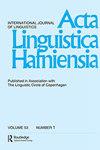“It is me”——丹麦语主语补语中用斜语体代替主格
Q2 Arts and Humanities
引用次数: 3
摘要
本文认为,丹麦语主语补语中主格形式被斜格形式所取代,是中古丹麦语主要结构变化的一部分。所讨论的主要结构变化包括中古早期丹麦语/中古晚期丹麦语从富格语言到贫格语言的转变,以及中古晚期丹麦语/早期现代丹麦语句子主语地位的变化。因此,人称代词格形式的分布从主要遵循传统的表达语义角色和句法功能的句法语义原则,转变为遵循主位和述位、突出和聚焦/反聚焦等信息结构原则。这种方法是功能结构的。本文章由计算机程序翻译,如有差异,请以英文原文为准。
“It is me” – the replacement of the nominative by the oblique form in Danish subject complements
Abstract In this paper, it is suggested that the replacement of the nominative by the oblique form in Danish subject complements happened as a part of major structural changes taking place in Middle Danish. The major structural changes in question involve the shift from a case-rich to a case-poor language in Early Middle Danish/Late Middle Danish, and the changing of the status of the subject of the sentence in Late Middle Danish/Early Modern Danish. As one outcome, the distribution of the case forms of personal pronouns changed from being primarily following the traditional syntactic-semantic principle of conveying semantic roles and syntactic functions to following principles pertaining to information structure with notions like theme and rheme, prominence and focus/anti-focus. The approach is functional-structural.
求助全文
通过发布文献求助,成功后即可免费获取论文全文。
去求助
来源期刊

Acta Linguistica Hafniensia
Arts and Humanities-Language and Linguistics
CiteScore
0.90
自引率
0.00%
发文量
5
 求助内容:
求助内容: 应助结果提醒方式:
应助结果提醒方式:


